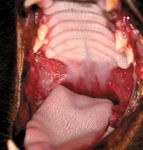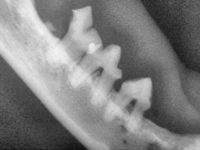Assessing, treating refractory feline chronic gingivo-stomatitis
Feline chronic gingivo-stomatitis is a painful oral condition in cats that therapeutically has only responded predictably to surgical extraction of all premolars and molars.
Feline chronic gingivo-stomatitis is a painful oral condition in cats that therapeutically has only responded predictably to surgical extraction of all premolars and molars.
Characteristic lesions are recognized as severe inflammation adjacent to the premolar and molar teeth with or without inflammation of the caudal oral mucosa lateral to the palato-glossal folds (incorrectly termed faucitis). (Photos 1 and 2)

Photo 1: Severe inflammation adjacent to the premolar and molar teeth of the right mandible of a cat with chronic gingivo-stomatitis.

Photo 2: Inflammation of the caudal oral mucosa lateral to the palatoglossal folds in the same patient as Photo 1.
Patients experience a wide variety of clinical signs, including anorexia, blood-tinged saliva, food dropping, lethargy, weight loss, halitosis and bruxing. Radiographic changes include evidence of bone loss, tooth resorption and tooth fracture (Photo 3).

Photo 3: Radiographic evidence of horizontal bone loss, tooth resorption and tooth fracture in the same patient as in Photos 1 and 2.
Studies suggest that cats that undergo extractions respond favorably 80 percent of the time, requiring no further therapy. Unpublished studies support a 50 percent response rate in cats where calicivirus has been isolated. (Girard N., Hennet P)
In either case, many cats require some degree of additional therapy to eliminate pain and/or control persistent inflammation in cases non-responsive to caudal mouth extractions.
Various modes of therapy have been used to attempt to alleviate pain and inflammation in cats that are refractory to surgical removal of the premolars and molars in cases of feline stomatitis. Aurothioglucose, thalidomide, bovine lactoferrin, clyclosporin, chlorhexidine and glucocorticoid topical gels, chlorambucil, megestrol acetate, hypoallergenic diets and laser therapy have all been used with some degree of success in certain cases.
Injectable glucocorticoids have been successful as a palliative treatment, but appear to lose their efficacy with repeated use and potentially pose significant deleterious effects to the patient. It must be stressed that all teeth should be examined for disease, and any canines and incisors that are abnormal or have adjacent stomatitis should be considered for extraction as well.
Client education is essential regarding the potential for non-response to initial extractions. Cat owners should be aware that some patients do not respond at all and require adjunct therapy. Expense is significant in both initial and follow-up therapy for refractory cases and should be discussed in detail. Calicivirus PCR aids in determination of prognosis for resolution. Calicivirus-positive cats have proven traditionally to be more refractory to caudal mouth extractions alone.
A recent case report describes the use of feline recombinant interferon omega (Virbagen; Virbac) as an aid in resolution of refractory stomatitis.2

Suggested Reading
A 7-year-old domestic short-haired cat presented for evaluation of severe generalized stomatitis. The patient's mucosa oral cavity was sampled via swab and calici virus was isolated. Two months after extraction of the premolars and molars, the stomatitis persisted. Feline omega interferon was initiated with injections of 1 mega unit subcutaneously on alternate days for 10 doses.
After the fifth dose, interferon omega was dispensed to be given orally once daily for two months, then every other day for 30 days. Significant decrease in inflammation was noted and viral isolation was negative at six, 10 and 14 weeks. The cat had only minor inflammation lateral to the palatoglossal folds six months later and was negative for calicivirus.
Five other calicivirus-positive cats had been treated by the same authors with the subcutaneous injection regimen but without oral administration of omega interferon. Three resolved, while one required chlorhexidine rinses for long-term management. The fifth relapsed, but a single treatment of intralesional injections resulted in resolution.
The exact mechanism of action of feline omega interferon is not known. It is a Type 1 interferon related to alpha interferon that stops viral replication by inactivation of translation proteins and destruction of mRNA.
Interferons in general are antiviral cytokines that have immunomodulatory effects.
Studies show feline omega interferon has statistically significant therapeutic effects on initial clinical signs and on survival times of cats with FeLV infection and FeLV/FIV coinfection.
Feline recombinant interferon omega is available in the United States only through the FDA Compassionate Use Program as a medically necessary personal veterinary import for an individual patient.
Those who have a patient that is calicivirus-positive and failed to respond to radiographically documented complete caudal mouth extractions might consider this option. Additional testimonials suggest similar results, but additional studies are needed.
Dr. Beckman practices referral dentistry at Affiliated Veterinary Specialists, Orlando, Fla.; Noah's Animal Hospitals in Indianapolis; and at Florida Veterinary Dentistry and Oral Surgery in Punta Gorda, Fla. He is president of the American Veterinary Dental Society and frequently lectures on veterinary dentistry.